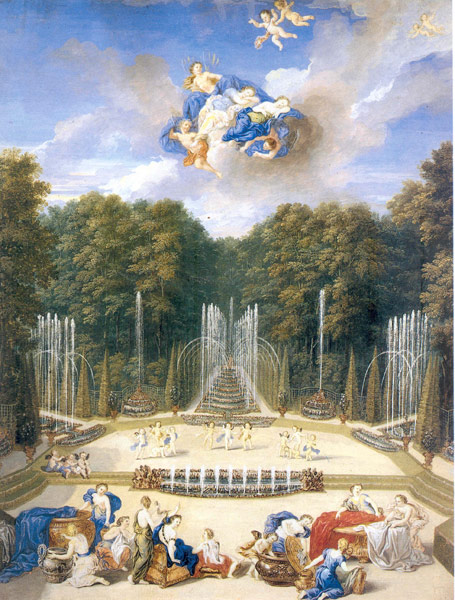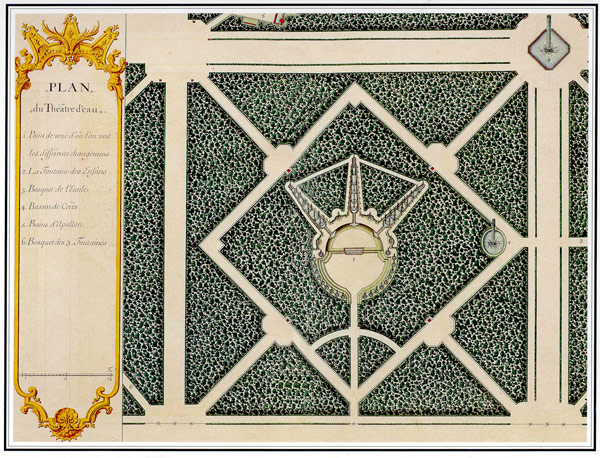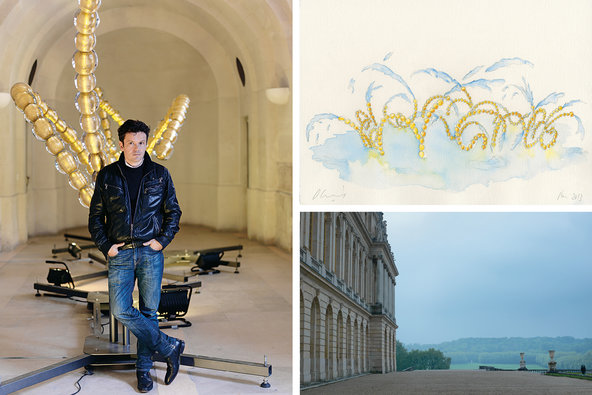
This summer, André Le Nôtre’s 17th-century Water Theater grove at Versailles has been restored by the landscape designer Louis Benech with contemporary sculptures by Jean-Michel Othoniel – the first new permanent artworks added the garden in over 300 years.

The Bosquet du Théâtre d’Eau, or Water Theater grove, was designed by André Le Nôtre and constructed between 1671 and 1674 during Louis XIV’s second building campaign of the gardens at the Château de Versailles. To the west of the Bosquet des Trois Fountaines, or Three Fountains grove, the Water Theater grove was originally one of the most complex and elaborate of the 15 groves in the gardens. It was enclosed by tree cover and trelliswork, designed as an outdoor salon and theater. Three tiers of grass formed an amphitheater facing a stage, which was surrounded by fountains and sculptures designed by Charles Le Brun.

The Water Theater was neglected through the 18th century and in 1775, during the reign of Louis XVI, it was replaced with a simple lawn. The Bosquet du Rond-Vert, or Round Green grove, was damaged by storms in the 1990s and then closed to the public.

In 2003, Versailles began a major project to replant the park and trees on the perimeter of the Water Theater were replaced to match the earlier configuration. In 2011, Versailles launched an international competition to redesign the Water Theater. The commission was awarded to Louis Benech, a renowned landscape designer whose previous projects include a restoration of the Tuileries gardens in Paris. Benech’s plan for the four-acre Water Theater grove will restore much of Le Nôtre’s design, which included many multiples of the number three. The Water Theater will include three alleys, three round pools, 18 Irish yew trees, and 90 live oaks, with an inner square of 120 meters and an outer square of 180 meters. As intended by Le Nôtre, and to preserve views from the Palace, none of the trees will exceed 17 meters in height.

André Le Nôtre collaborated with then-contemporary artist Charles Le Brun to design sculptures for the 17th-century Water Theater, and Louis Benech has commissioned three fountain sculptures by the contemporary French sculptor Jean-Michel Othoniel. Othoniel is known for a pair of glass bead sculptures, Le Kiosque des Noctambules, that form cupolas above the Palais Royal – Musée du Louvre Métro station at Place Colette in Paris.

For Versailles, Othoniel’s sculptures are comprised of some 2,000 large glass spheres installed in the fountains and fitted with 17th-century style water jets. The contemporary works, Les Belles Danses, are informed by the artist’s research of Louis XIV’s interest in dance. From a rare copy of L’Art de Décrire la Danse, a 1701 book of notations on baroque dances created for Louis XIV, Othoniel interpreted the form of his sculptures. He identified that the Sun King took his nickname, at age 14, after a ballet interpretation of Apollo. (The Bassin d’Apollon, or Apollo Fountain, forms a primary focal point before the garden’s Grand Canal). Gold glass spheres are another reference, and blue spheres will mark the locations of fountains in Le Nôtre’s original design. The blue glass is manufactured by a workshop in Murano, making a further historical connection with the Venetian glass in the Palace’s hall of mirrors.
Benech and Othoniel have made the contemporary installation with deference to the Water Theater’s history and a focus on restoration. The new project is entirely reversible and has preserved masonry and fountain hydraulics that exist on the site from Le Nôtre’s original construction. From September, the Water Theater grove will be open year-round to accommodate approximately six million annual visitors.
€1.4 million in project funding has been directed from a €5 million sponsorship from the late South Korean businessman Yoo Byung-eun, who was also a photographer known as Ahae and essentially rented the Orangerie for his 2013 exhibition, Fenêtre sur l’extraordinaire.